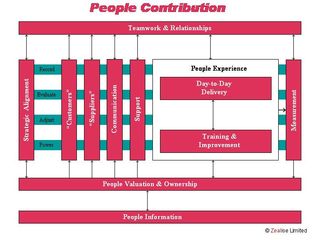I have always known that my idea of treating people as assets would invoke debate. I always anticipated a possibly lively discussion about how you assign a value to a person. And, of course I have to admit that it crossed my mind that, as part and parcel of that, there could be people who argue that it implies a sense of ownership that is inappropriate and undesirable. Naturally I expected to have to make my case.
But I never thought it would be controversial.
Yet, it would seem that it is. It appears that I might have been naïve in failing to foresee just how passionately those people would feel. So, you can imagine how surprised I was this week when, in response to some publicity for my guide booklet "The 7 Deadly Toxins of Employee Engagement", someone wrote a comment on LinkedIn to say that describing people as assets "was the 8th deadly toxin!"
Of course at one level I can understand this. After all it was hearing for the gazillionth time someone say "our people are our greatest asset" that started me on my mission to have it taken more literally. So I understand the hypocrisy of that statement better than most. I see how galling it is for people who feel that they are never treated as assets. And thus, in a sense, I can understand how you could regard it as the 8th deadly toxin.
But my challenger was not objecting to the hypocrisy that goes with the statement. He was arguing that it is totally wrong to regard people as assets. For he actually wrote, "People are people, and can never be assets."
Does that shock you? It does me! After all, semantically speaking, if you don't see people as an asset, you see them as a liability. And you have to be utterly cynical or disillusioned to consider people in that light.
From an accounting perspective there are only 4 elements: asset, liability, income or expense. And there you have the crux of the problem. Historically you account for people as a cost. This effectively shapes all organisational behaviour. It is so ingrained into your management thinking you are not even aware of it. Yet this demeans people and makes them disengaged. It sabotages all your efforts to build employee engagement without you ever being aware of it. So you have to remodel the way you regard people to reshape your behaviour. And accounting for people as assets will enable you to do that.
People will never be engaged so long as you demean their contribution by trying to reduce the part they play. It is not calling people assets that is the 8th deadly toxin, but accounting for them as costs.
In fact there other good reasons to account for people as assets. You can get a good idea of these from the diagram, which shows just how much of a contribution people make to your business.
It shows how you depend on your people and how valuing your people improves your day-to-day operations. You optimise performance because:-
-
You determine a person's value by their contribution to the business; and
-
Their value determines their individual reward.
The relationship between the two ensures this – especially when cemented by my employee ownership model. It creates a common purpose that aligns individual self-interest with that of the organisation. This creates a natural employee engagement that creates a win-win for both. It also means that people will manage themselves to optimise their own performance, and in the process reduce your burden and improve the quality of your life.
So, if you felt that people could never be assets, I hope you are now convinced. This offers you a solution that nothing else does, and to more than just your employee engagement challenge.

